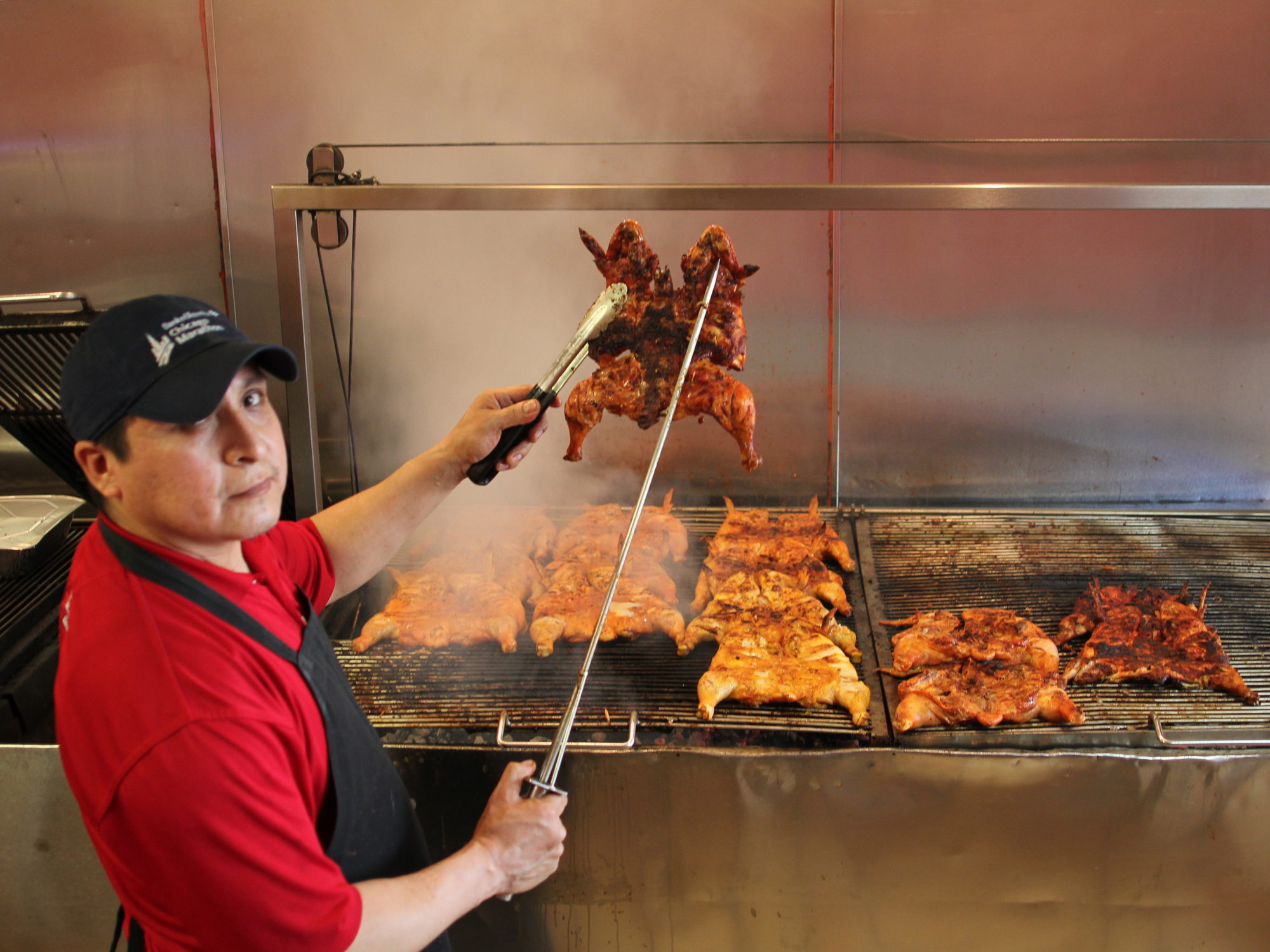TWO YEARS AGO THIS WEEK THERE WAS A POP-UP at Arami, the West Town sushi restaurant, where the guest chef was Rick Bayless. Now, Arami’s a well-respected place, but it doesn’t usually get world-famous chefs with TV shows to give up their Sunday nights to spoon up Japanese-Mexican miso ramen pozole (which was fantastic, by the way). That Bayless did that, I figured, was a sign of his esteem for one of Frontera/Topolobampo’s cooks, Lisa Despres, whose husband Fred was one of the chefs at Arami. (Fred, born in Korea, acquired a famous Chicago name when he was adopted—his grandfather was the Hyde Park alderman and reform figure Leon Despres.)
In any case, it soon turned out Lisa wasn’t the only Despres in the kitchen that Bayless thought highly of. In March he announced that the husband and wife team would be in charge of Leña Brava, the seafood-oriented, more upscale half of the restaurant and brewery complex he was building on Randolph Street. Leña Brava (and its tacos-and-beer sibling, Cruz Blanca) opened on Cinco de Mayo, and has been booked ever since with diners seeking its menu, which is cooked entirely on the blazing wood grills and ovens visible in the dining room.
Bayless did plenty of interviews as Leña Brava was about to open, but no one’s really talked to Fred and Lisa Despres since the restaurant has been running. So five months in, I figured it was time to meet the husband and wife team at one of Chicago’s hottest new restaurants.
FOODITOR: How did you two meet?
FRED: We met at Takashi restaurant, at Damen and Armitage—it’s not there any more. That was back in 2008, 2009. We dated for about a year, and then she split to go to Frontera. I continued with Takashi for four more years, and I opened Slurping Turtle with him as well. She followed her passion for Mexican food, which I guess started as a little girl—
LISA: I grew up in Joliet, which has a huge Hispanic population. But what I thought Mexican food was, was not what it is, and the more I got to know about it, I loved it even more. I mean, I grew up with pink tomatoes and iceberg lettuce, Ortega tacos, right?
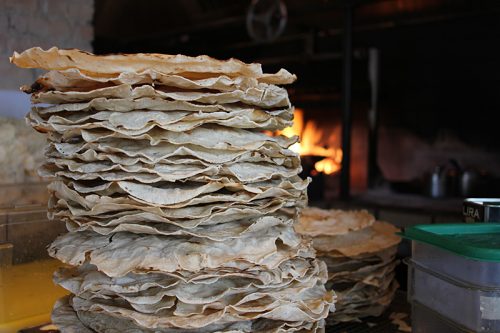
Tlayudas, which are made in Oaxaca, shipped in cardboard tubes, and reheated over fire to order.
We got married a week after I started working at Frontera. And Rick just got to know Fred from events, any time he had an event—
FRED: Rick also has a pretty fond love for Japan, and I was working at Arami then. And this idea just came about from me showing up at Frontera and Topolobampo every now and then to work these events, and Rick thought about how great an idea it would be to combine both cuisines, and so we did this pop-up.
LISA: That pop-up was really fun because I loved Mexican food and I loved Asian food, Japanese food, Korean food, and it was something I always wanted to do. It’s really neat when you have these ideas in your head for so long, and you get the opportunity to make them real.
So would you say that there’s a Japanese tinge, or similarity of philosophy, to what you’re doing here?
LISA: I guess so… but it’s definitely not fusion. No way. They are to their core Mexican dishes. We don’t think like, man, what is this Japanese thing that we could make Mexican. It’s always what are we going to make…
FRED: Using Asian or Japanese ingredients.
LISA: But where they fit. Nothing is forced—that’s been kind of an interesting thing too, to watch that happen. It’s been really exciting, and I’m interested to see where it goes—we’re just doing baby steps into menu changes. Now that we’re actually in the building and working on our equipment, it’s a different experience creating things. Because all this menu was created when this was still under construction, at Xoco where’d we use the woodburning oven, or Frontera and Topolo where we’d use the grills. We both worked the lines there, to be familiar with the wood fire stuff—I’d worked at Topolo for a long time, I was their butcher, and I did sauces in the morning, made all the moles for a year and a half, probably.
Well, let’s talk about that equipment that everybody notices first when they walk in here, the big wood fire grills. It’s not just that you have fire to cook with here—you only have fire, no gas stove or cooktop. How has that been to work with?
LISA: It’s really cool, I think, and I feel like we’re getting accustomed to it. It doesn’t seem so bizarre to us any more. It took us a while to wrap our heads around it and figure out, how are we going to make these things happen. Slowly, we’re starting to not miss gas.
FRED: It’s definitely been an adjustment.
LISA: Pretty quickly we realized our original concept for the grills didn’t work, we wanted to do things Argentinian style, and we were just too busy for it and realized we had to lift it up and make it an American-style grill.
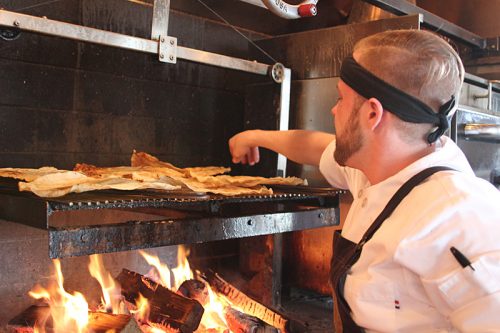
What’s the difference?
FRED: The way the kitchen was intended to be was using these Argentinian grills where you have the fireboxes where you stack the wood and it lights on fire and then the coals drop down underneath, and then you push the coals under whatever area you want to cook.
LISA: There’s no live flames, it’s just coals.
FRED: We tried that for maybe the first week, and with all the customers, we just couldn’t keep up with the demand, so we just thought, why not lift up the grills, put the logs under there instead of using charcoal—
LISA: And it’s what we built our menu from. We didn’t have an Argentinian grill [to develop recipes on].
What are some things that you’ve tried and been like, “How do we do eggs on this,” or whatever?
LISA: You know, we actually haven’t done eggs. We’ve been talking about, how do we execute this, and we’ve had some crazy ideas. Like we thought we could cook off the base of the woodburning oven, but there’s just so much ash that it doesn’t really work out.
But I’d say our tlayudas were definitely a learning curve. You think about grilling these super-thin, dried, giant tortilla chips, basically, for lack of a better term, and that definitely takes finesse to have the right level of heat, the right amount of time that it goes on, because if you don’t do it enough they’re chewy, and if your flame’s a little too hot they burn right away, so that took us a while.
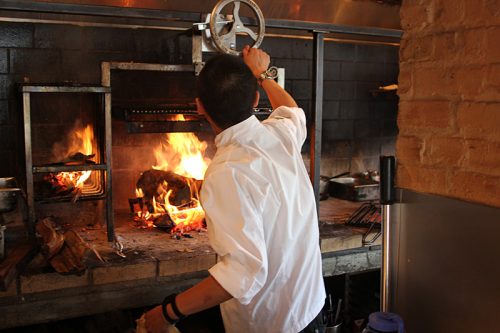
And then doing the whole fish, too, was a pretty cool process. We got to develop the baskets, we went to Chinatown and worked with the iron workers to make the right baskets, the right material, the different sizes.
But it’s been neat, too, doing menu development and thinking, how can we tie in fire. What are the different ways that you use fire and wood smoke. Or cold smoke, or using the working oven like a grill. Cooking something in the woodburning oven gives a different flavor than over a grill. Even though it’s the same wood, it’s a different environment for it. It makes different flavors. Everything has a little tinge of smoke, but the way the product is seared, the level of smoke that comes out, it just is a different thing. So trying to decide, well, this tasted better out of the oven than off the grill, has been fun for me at least.
Let’s talk about menu development from the beginning, starting with the concept of it being related to Baja.
FRED: Well, to begin with, the restaurant was going to be primarily focused on seafood, not necessarily Baja. But we went on a research trip, partly to go visit the farm that we use for yellowtail hiramasa. We use that fish in, I think, three of our dishes right now.
But when we were down there, we realized that with all of the cultural diversity, and the diversity of fish that’s down there, as well as the cooking style, it was conducive to relating this restaurant to that area.
LISA: It was the perfect fit on accident.
FRED: Yeah, it was kind of on a whim that that idea came along.
So what does that mean in terms of dishes, as opposed to the Yucatan or anywhere else that’s on the water?
LISA: What is so amazing is that Baja is the most culturally diverse region in Mexico, and so that gives us so much freedom. They have an enormous Japanese population, and Fred with his background is able to bring that kind of element. We are much freer than the other [Bayless-owned] restaurants, they’re sort of tied to these ideas that people already have about Mexico.
I came from Frontera where so much of the cuisine is sauce-based, but in Baja they don’t have that—so it was really challenging to think, what’s Mexican food without the sauce?
Many people don’t know about Baja. And because it’s so culturally diverse, and has influences from so many places, we’re able to use so many different ingredients and so many different styles, and have it still be Mexican. It’s much less uniform or cut-and-dried style of food. Of course, everything has a Mexican cornerstone, and touchstone dishes—but we’re making Mexican food in Chicago. Which is an interesting thing to think of—it’s done in the same style of Mexican food that we have around us, but the key ingredients are the things that really make it Mexican, like chilis, cilantro, lime.
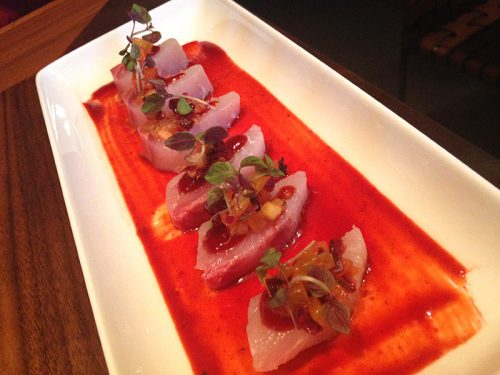
Hiramasa laminado
Which was interesting, and I wasn’t quite sure what to think about it, when we had the hiramasa laminado, which most of us would call a crudo, and you expect citrusy flavors in a crudo. And instead it had these kind of earthy, almost corn flavors—you can tell me what they actually were—
LISA: The idea for that dish came from a drink called the mangonada, it’s something you can get from a paleta store or a street vendor. It’s basically a mango puree, and they put chimoy and tamarind in it. And it’s just this super-sour, crazy desert thing that I was obsessed with. That evolved into a raw seafood dish. On the base of the plate is chimoy, and where you’re getting earthy from is fried guajillo [pepper], and there’s chipotle powder in there as well. The fried chili paste is grounding what would be a super sour/sweet thing.
So were there Baja-regional ingredients that were new for you to play with?
LISA: I know for myself, coming from Frontera where so much of the cuisine is sauce-based, and then in Baja they don’t have that—so it was really challenging to think, well what does Mexican food mean without the sauce? That opened up a whole new way of thinking for me.
Specific ingredients, for Baja, I don’t know if that was so much an inspiration as the style of the food, and the range we could do. There’s nothing that’s like—oh, you only get that in Baja, at least that I’m aware of, like you have in other areas of Mexico. Like the Yucatan is sour orange, and that’s their thing, you know? I don’t think Baja really has a calling card like that—
FRED: Olives and grapes—that’s the Mediterranean thing—
LISA: Olives and wine, I guess. That seems like kind of a boring answer.
The live fire cooking is a thing that’s very Baja. For everybody, to do things over a hearth, over fire, in a woodburning oven—that’s definitely a Baja thing.
FRED: Yeah, that’s present in every restaurant.
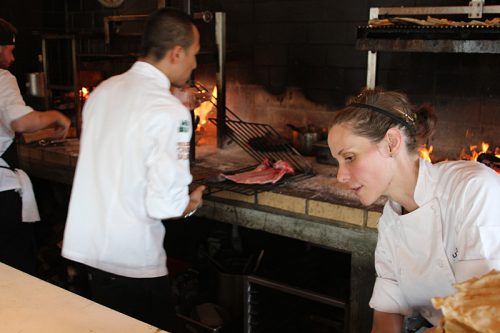
Sea bass going on the grill
One thing that’s happened pretty quickly is that the whole fish has become a star dish, the grilled sea bass which you offer with four different choices of Mexican seasonings. It’s really just perfectly executed, it could not be improved on. How did that become the focus of the entree portion of the menu?
FRED: Well, first because we’re a seafood restaurant, and second because we wanted to have this dish that the restaurant could be known for. We’re using a bass that’s farm-raised in Texas, although we’re about to move to a striped bass that’s farm-raised in Baja. It’s like our mainstay.
LISA: And it’s very much something they do in Baja. The split fish on a live fire by the beach—it’s a thing that happens throughout Mexico, but prominent in that area. It’s a very striking thing—it has such table presence.
We’re really fortunate that Rick and Deann are so generous, and to be able to get to go to Mexico and experience it there—it’s, how would you say it, the best kind of learning—
FRED: It brings authenticity to our knowledge, and our creativity.
LISA: I always feel like the things we end up with are better, our stuff tastes better, but to see where the ideas come from and to experience the culture—and we want to bring a little of that here. And I think that’s really true for Rick and Deann overall, that they want to share what the culture of Mexico feels like. And so that’s what we try to do, make people happy and comfortable.
Is all the fish farm-raised?
FRED: About 75% of the fish is farmed, and the rest is wild. The two main fish we use are the hiramasa and the sea bass. When we went down to Baja, we went into a state of the art facility, a humongous warehouse, and maybe a quarter of the building was in use. They’re still a new company, about three years old, and they’re essentially the leading company for the future of fish farming. Along with their sustainability practices, the Baja hiramasa that they grow there is native to that region, where the bass that we’re going to be using isn’t native to that area. It’s an authentic fish that comes out of that area, so that’s part of the reason why we chose it.
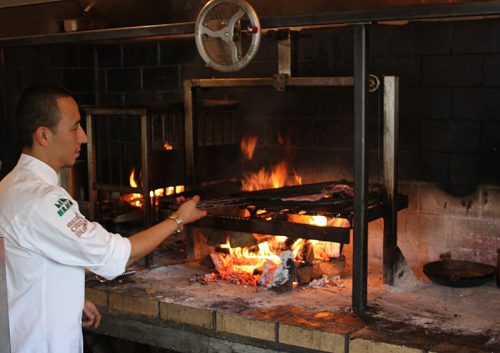
Sea bass on the grill
The striped bass from Texas, it’s a hybrid, it’s actually a cross between striped bass and white bass. The flavor of it, we thought it was good and it definitely allows all the marinades to shine through. But we’re moving to this Baja fish because we feel that the fish holds up more to the marinades. The emphasis is equal on both, instead of wow, taste this marinade that accompanies the fish, or taste this fish that accompanies the marinade—
LISA: He’s excited. We’re all excited. It’s a really great product.
How many do you go through a night?
FRED: About 25 to 30.
LISA: They can only do four at a time, so… 30 bass is pretty good. But now that we’ve been going a little while, and know our equipment, we’re excited to start bringing in more product, do daily specials. But there’s just so much that goes on in the beginning—we’re looking forward to the future.
Let’s switch topics—how is life working together in front of a hot fire?
LISA: Actually not so bad—we need to find something else to talk about at home, other than work. But that’s all that we do, so that’s all we have to talk about.
FRED: We’ve had our struggles, but overall, love prevails. We love working with each other, and we have a lot of passion for what we do. It’s great at work and outside of work.
LISA: Awwwwwww…
Good answer, man.
LISA: It really has made us stronger in some things. Also pushed us in a lot of issues. But I really feel it went much better than I thought it would. I feel like a lot of that came from things just going smoother than I had anticipated. We’re both still here and breathing.
When we worked together at Takashi, that was really hard but that was the beginning of our relationship. And Rick asked me, is this something you feel comfortable with? Can we do this? And I was like, umm… I thought about it, and you’re with somebody for a while, and you know, it’ll be okay. We decided to try it. Though we do work different shifts right now.
We actually just ate here together for the first time—with Fred’s mom and dad. It was an interesting experience, being in the dining room. We had to force ourselves to not look at the kitchen. It’s really hard to be a chef and go out to eat, especially your own place. It’s hard not to be hypercritical, it’s a struggle to just relax and enjoy. At least for me, I’m too high strung. And we’re in a bubble—it’s hard to see this from the outside, because we’re down in it every day.
Well, it’s good, trust me on that one. Have you eaten anywhere else in this neighborhood?
LISA: We don’t get to come to the city too often—we live really far away. I know this is not the answer you’re looking for, but J.P. Graziano’s has been there for 87 years and there’s a reason. We survive off of that. And there’s the little place, Jubilee Juice—when we were opening and we were all half dead, we were surviving on smoothies. And breakfast sandwiches.
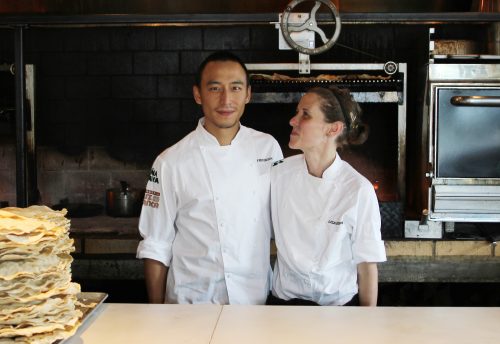
Fred and Lisa Despres
But we’re hoping to get time to start coming to this place, because this is such a unique area, too. Of course we went to the Green City Market to do research to compare [produce] with our crews.
FRED: We haven’t really done that much eating in this area, but my family on my father’s side is from Hyde Park, so we’ve done a good amount of eating down there. We’re hoping to do more, but you get home and all you do is take care of the dogs—
LISA: The last two years our lives have disappeared.
Michael Gebert has a little tinge of smoke as the editor of Fooditor.
Latest
Join the Discussion
After you comment, click Post. If you're not already logged in you will be asked to log in or register with Disqus.







